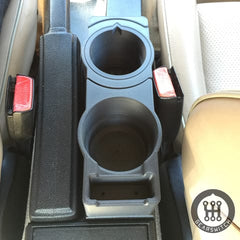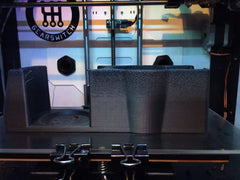Testing of Wear Resistant Hercules Nozzles
More makers and companies are using high performance materials such as metallic, glass fiber, and carbon fiber filaments in their specific applications to achieve new levels of performance. Unfortunately, this performance comes at a cost: fast erosion and wear on the nozzle orifice and tip which leads to changing extrusion diameters and reduces the quality of prints. This also means buying more nozzles and swapping them more frequently, which of course means less time doing what you want to do: print cool stuff. Through our testing, we've found that our Duraplat3-d™ Elite nozzles have 5 times the wear resistance of a standard brass nozzle, and our Duraplat3-d™ Hercules nozzles last 67 times longer! Below is a case study of some of the testing we've done where you can find all the details.
When we decided to make a line of super hard wear-resistant nozzles in the summer of 2015 to address this problem, we knew they would perform much better than regular brass nozzles, but we also had to pit them against the Durplat3-d™ coated nozzles to see how they would stack up. That's when we enlisted the help of Ryan Carag from Gearswitch.us who volunteered to buy and try our Hercules nozzles.
Ryan prints a variety of products, and in particular has printed hundreds of his sleek center console cup holder for the BMW E30.

Ryan uses high quality carbon fiber ABS filament from 3DXTech to digitally manufacture the product, and because Ryan has hundreds of prints under his belt he can quickly spot nozzle wear issues when the fit, finish, and consistency of the prints begin to change.
With CF ABS wearing down brass nozzles in as little as 100-200g, Ryan obviously had to find a better solution to keep consistent part quality. He originally tried our Elite series of plated brass nozzles and had this to say:
I've printed with several hard-plated brass-base nozzles, and also several steel nozzles. Currently, my best experience when balancing extrusion-speed, life and nozzle cost has been with the P3D low-friction nozzles. I am finding lifetime of the nozzles before quality degradation to be around 850 or so grams of CF-ABS with fairly aggressive first layer tramming and parts with a lot of flat horizontal surface area. The quality stays very consistent for about 90% of that before it starts to fall off. So I've been sticking to swapping the nozzles at each 750g filament roll change, Stratasys style. The extrusion during this lifetime is more consistent than other nozzles I've tried. They also can extrude significantly faster (~20%) than the steel nozzles I've tried so far (both MK10 and E3D style). For some of my parts, this is the difference between 8hr and 10hr cycles, which is quite significant when added up over a parts run.
As you know, the CF-R ABS will eat through a normal brass nozzle, as most printers are equipped with, in something like 250g or less. I've seen it as bad as 125g before I could put a 0.5mm bit through a 0.4mm nozzle.
Here is picture from Ryan showing the point of no return (basically total nozzle failure).

As you can see, just over half way up the surface finish gets progressively worse and even though the print finishes, it is clearly not a usable part.
Ryan then began testing out our Hercules nozzles, which are precision machined from A2 tool steel. After machining, the nozzles go thru a special vacuum heat treating process which increases their hardness to 58 Rockwell all the way through. Finally, they are put through our Duraplat3-d™ coating process, which gives the surface a very low friction coefficient and also further increases the surface hardness well into the 60Rc range.
Testing took a while, and one month in Ryan gave us this update:
Done with the 5th roll and into the 6th. ~3550g so far printed through the Hercules MK8 tool steel nozzle and the parts are still coming out beautiful, consistent, and with spot-on dimensions, so I will keep printing with this same nozzle.
For me, the durability has been second to none, the print quality and consistency has been as great. Also, at your asking price for the tool steel nozzles, the cost for nozzle wear per carbon fiber ABS part is drastically reduced. As a side note, the reduced need to level the build plate has opened up the ability for me to achieve something I've been wanting to do with my setup; full automation.
And after another 2 months…
I've got one at ~10kg and it's still running great. Just did a fairly sizable run of parts after having a Black Friday promo and the nozzles worked excellently. Knowing the nozzles would keep on going really removed a lot of anxiety that's endemic to manufacturing with a small print farm.
There's one particular part that I print where there is a precise hexagonal feature for a M3 nut to press fit into. With the brass nozzles, I could basically gauge about the halfway point of their usable life when the fitment on that nut was starting to loosen on parts coming off the printer. The nozzle that has had 10kg through it has not gotten to that point yet.
I also have parts that slide-fit into one another, and the tolerances are very important to the "feel" of that slide-fit. This has been dramatically more consistent versus the brass nozzles.
You read that right: over 10,000 grams and still running great.
As most users know, Ryan confirmed that printing abrasive materials is best done thru an all metal hot-end. Ryan paired our coated thermal barrier tubes and MK8 nozzles, along with E3D nozzles for the testing. He also tested the MK10 style and as expected, found the PTFE (Teflon) tubing to be the limiting factor with that setup.
Ryan did also experience the occasional clog when printing with the 0.4mm nozzles:
Only nitpick has been occasional clogging when printing at 240C, which I found is alleviated (maybe eliminated) by simply running a length of plain, unfilled ABS through the hotend (using filament load) at each spool change.
On the nozzles that did clog, simply soaking them overnight in a small container of acetone got them back to fully serviceable with no other work.
This is one reason many users, especially ones newer to printing with exotic materials, may want to consider stepping up to the 0.5mm, 0.6mm, or even 0.8mm nozzles to reduce or eliminate any clogs. Note that this will require changing your slicer settings.
Ryan found that the wear life of various nozzles using carbon fiber ABS filament to be:
| Standard Nozzle | Uncoated Brass | 150g | 1x (baseline) |
| P3-d Elite Series | Duraplat3-d™ Brass | 750g | 5x |
| P3-d Hercules Series | Duraplat3-d™ and thru-hardened steel | 10,000g+ | 67x |
Thanks for reading, and you can find our nozzles here.
For reference, here are some of the settings that Ryan used while printing:
Versus MK8 brass baseline:
- Needed no extrusion multiplier change
- Ended up at about 5C higher setpoint and getting very nice surface finish and good layer bonding
- Can run at 100% speed with no infill breakage or delamination issues
- Speed settings for reference:
- 95mm/s 0.6mm sparse infill
- 76mm/s 0.6mm solid infill
- 45mm/s 0.4mm perimeter
- Checked level with each print, and bed did not need re-leveling for the entire roll.
- The low tip wear gives me confidence in being able to run these nozzles with CF-R filaments in a dual-extruder setup with a dissolvable support or second material extruder. The high wear of other nozzles with CF-R filaments would mean frequent re-leveling of the dual nozzles, so I've avoided using a support extruder or multiple material (eg: a TPE soft liner embedded into a CF-ABS print) with CF-R filament. The toolsteel nozzles put this within practicality and opens up a lot of options for parts geometries and multi-materials using CF-R filaments.


